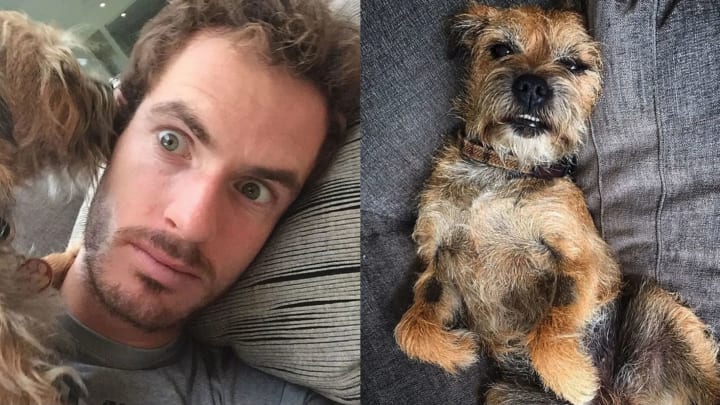
Our Friends
As far back as I can remember, I wanted a pet. Honestly — for the longest time, it’s all I wanted in the entire world. It really didn’t even matter to me what it was. It was more the concept of it that seemed exciting. To have this animal companion, who was your best friend … what could possibly be better than that?
When I was 10, I finally got one: a hamster named Whiskey. At first, Whiskey mostly just lived in his cage. And I’d spend hours with him — watching him, playing with him, talking to him, feeding him. But after a while, in my mind, the cage began to seem too restrictive. I wanted Whiskey to be able to run free and hang out like a human.
(I’m 10, remember.)
We had one of those big, old-fashioned sinks in our bedroom. And so I tried to rig it with a rope holding down the drain, so that Whiskey could play in the sink. I thought it was brilliant, and Whiskey seemed to be having a great time — a real win-win.
(Again, 10.)
Of course, my sound logic did not completely hold up. It probably won’t shock you to learn that a few weeks later, Whiskey ended up solving the rig and managed to scurry all the way down the drain of the sink.
Ten-year-old me was just devastated that he was gone. We set up a trap, with cheese — not one that would kill him, but just catch him so we could bring him home to safety — but never had any luck. Every time we tried it, the next morning the cheese would be gone … and there would be no Whiskey. It just wasn’t meant to be, I guess. Looking back, I like to think that if Whiskey was smart enough to beat the trap, then he was smart enough to make it on his own.
If you’re not an animal person, you might laugh at this. But I can still vividly remember how sad I was about it. It really felt like I had lost a friend.
Even at 10 years old, I knew: while animals aren’t human, that doesn’t mean they aren’t alive. There’s just something about them. If you get it, you get it. And I got it early on. I’ve loved animals ever since.
Once Whiskey left, we got a dog — a golden retriever named Abby. Abby lived at my grandmother’s house, but she was right nearby. So all through childhood, we had this amazing dog in our lives. We would do everything with Abby: play with her, walk her, hang out and do nothing with her. She truly was just part of our family. You hear “man’s best friend” so often, to the point of cliché. But that’s just it, really — at a certain age, growing up, Abby was my best mate.
And once we decided to start our own family, Kim and I knew right away that we wanted dogs of our own. We got two border terriers, a boy and a girl: Rusty, named after the great Lleyton Hewitt, one of my all-time favorite tennis players. And Maggie May, named after our favorite song, (you guessed it) Rod Stewart’s “Maggie May.”
To say we love having them would be an understatement. Honestly, I can’t imagine our lives without them.
What are they like? Rusty is really vocal indoors. When we’re home, if he wants something, he’ll let you know about it. And if he doesn’t get what he wants … oh, man. Then he’ll let you know about it tenfold. (He’s more of a “woof!” guy, and less of a “c’mon!” guy, than his namesake.) But then once we head outdoors as a family, Rusty can suddenly get a bit shy. He tends to be very mild-mannered when we’re out in the world, one of the least confrontational dogs you’ll ever meet. This means he gets along with other dogs very well — which is actually a fairly rare trait. In the end, I suppose Rusty is just a big softie. (And I know he’ll be rooting for Lleyton this month in Melbourne.)
Maggie May, on the other hand, is an introvert when we’re around the house, very quiet and sweet. But once we go out on the town … not so much. Maggie has a great nose — which, unfortunately, also means that she has a great nose for trouble. Lots, and lots, and lots of trouble. (She didn’t get her nickname, “Maggie Mayhem,” for nothing.) But it’s usually all in good fun. I like to think that Maggie just has a “big personality,” as they might say in Hollywood — and simply wants to do the world the service of sharing that personality with everyone. Oh, and Maggie is also a bit of a social media addict. Here’s a link to her Twitter, since I know she’ll get upset if I leave that out. And, of course, like any good social media star, she’s parlaying her success into a book. How to Look After Your Human: A Dog’s Guide comes out later this spring.
But even more powerful than the bonds of companionship between the dogs and Kim and me, I think, are the bonds that Rusty and Maggie have with each other. Maybe they’ll have the occasional sibling squabble, but in general R and M are famous friends. They love spending time together, they keep one another entertained to no end, and their dispositions just complement each other’s in the way that brothers and sisters often do. Rusty even makes regular cameos on Maggie’s Twitter — the ultimate seal of approval. (Still no account of his own, though. He’s old school.) In the end, they really are just each other’s best mate. It’s pretty special to see. Now if I could only get them to FaceTime.
My whole life, I’ve always been fascinated by animals, and have sought out learning about them however possible. I just try to soak in everything I can. And it’s the strangest thing: I’ve found that, anytime I learn something new about animals, that information then ends up being illuminating — in some completely unexpected way — about my own life within the larger scope of world.
For example, the other day I was watching this great David Attenborough documentary on penguins. And on one level, sure, it was about penguins: how they live and interact; how they survive those Antarctic winters; how they are away from each other for months. But there was also this other level to it, that really hit me and stuck with me long after the documentary had ended: how penguins help each other, and communicate with each other, and sacrifice for each other, and care for each other … in this way that seemed so foreign to me.
And it’s sad that it’s so foreign. The truth is, we could learn a lot from penguins. We have a society where no one really wants to listen to each other, and no one seems to want to help each other out. We live in a world where everyone wants to assume the worst in everyone else. And sometimes, amid all of that mess, there can be this strange clarity gained, I think, by perceiving things on this elemental level — the level that comes with remembering how we really are all animals. You might laugh … and yeah, of course, I get it. It’s funny — they’re just penguins. But it really does help to simplify the world for me, a bit — and in this hopeful way: just reminding myself that all of these animals are living creatures. And that they have a lot to offer. You just have to pay attention.
Unfortunately, many people in today’s world go in the opposite direction. It seems as though animal cruelty runs more rampant — and is more bizarrely justified — now than ever before. So many animals are tested on, mistreated or killed under reckless pretexts. As I’ve gotten older, this is something I’ve come to believe in, deeply: that the reasons we use as a society to kill animals are simply not good enough.
Sometimes, they’re flat-out monstrous. Take Cecil the lion — an unbelievable tragedy: just some rich guy, for whatever reason, flying thousands of miles to kill this beautiful creature for sport. And Cecil, sadly, is not an isolated event. These are not instances of people killing to eat, or to survive. This is just arrogant, and needless, and cruel — and wrong. These animals need people to stand up for them — and make their safety a priority.
That is why, out of all of my charity work, one of my associations I’m most proud of is with the WWF. In November 2014, I became a Global Ambassador for the WWF. And I’m thrilled to report that, over the last year, we have made — and continue to make — a lot of cool progress.
One progress-area I feel a particular sense of determination toward is our work in the fight against illegal poaching and wildlife trade. These are crimes that are robbing us of some of the most beautiful animals in the world. I believe very strongly that we have an explicit responsibility, as people, to protect endangered animals — and so I’m doing all I can.
An effort that I’ve become involved in within this broader initiative is the WWF’s sniffer dog programme. It turns out that there are specific dogs that can help a great deal in the monitoring and detection of poaching — all they need is training. So far, we’ve helped to fund that training for two dogs in particular — a pair of Belgian Shepherds named Murray and Spears. (No idea who came up with those incredible names.) They’re in Nepal, as we speak, and I’m hopeful that they will be able to play their part in helping to curb these sad, criminal acts.
I’m also working with United for Wildlife — Prince William and Prince Harry’s animal charity. The charity often works alongside WWF and has recently been helping combat illegal wildlife trade across the globe as well.
But here’s the thing: Whether you’re an animal lover or not — to me, it doesn’t matter at all. We should have a duty to animals purely as citizens of the world. Animals are alive — it’s as simple as that. And life, whoever’s it is, should be treated with much more kindness than we so often grant it.
Humanity is not just about how we act toward humans.
It’s about how we act as humans.
*
Click here to read about Andy’s other charitable efforts. Andy recently raised more than £83,000 ($120,730) for UNICEF through his “Andy’s Aces” initiative.

